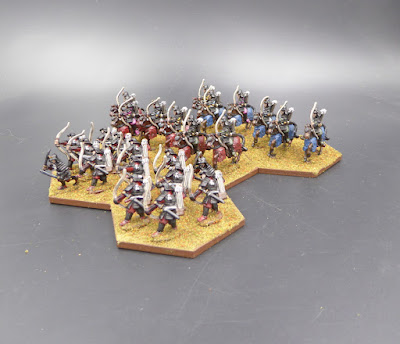In a recent blog post (When is a Historical Wargame Historical?), the author puts forward the question of whether attempting to recreate a historical battle on the wargaming table can attain the desired goal. As an example, the recent Battle of Auberoche, fought between Peter and myself, was sited. My account of the battle can be re-read at Battle of Auberoche. Did this game recreate the battle faithfully? If not, can this action be classified as an historical wargame? Refighting Auberoche provided an exciting contest which came down to the wire but was this really Auberoche?
For those wargamers who enjoy refighting historical battles, the gaming objectives and approaches are many and varied. I suppose one question to ask is what is the desired goal in refighting a historical battle. Why do we do it? Does choice of rules matter? Does type of game matter when viewed along the Game vs Simulation spectrum? Do game constraints such as time, space, figures available, number of players,etc. affect these goals?
I admit that my preference leans toward refighting historical battles. Even given great care in preparation and research, are we still fighting an historical battle once the maneuvers and shooting begin? For me, these attempts at historical recreations are exercises in decision-making. Always keep in mind that the historical outcome may be one of a number of possible outcomes. The historical outcome is singular. Any historical battle may hinge on a single decision point, a singular battlefield occurrence, or a string of such events. Same holds for a wargame.
A well-designed, historically motivated wargame attempts to place players into the boots of their historical counterparts. The wargame may begin from the historical situation (or at least the author's representation of the historical situation) but as the game evolves, so does the narrative. Must the wargame necessarily follow the historical narrative? Of course not. We want to encourage the table general to make his (or her) own decisions without following the choreographed decisions made by the historical counterpart. If the situation and objectives are set properly, one might expect to see generally, historical results in repeated trials. That is, if the historical result represented the most likely outcome.
As GM, I want players to consider the choices made within the confines of the historical situation faced on the gaming table in miniature. When wargaming, I want to make meaningful decisions on the path toward accomplishing the goal laid before me. I want to gain insight from the experience.
Consider as a case in point the game currently on the table. On the table today is a recreation of the Franco-Austrian War Battle of Montebello.
Each player or team of players received a battle briefing beforehand containing a brief generalization of the situation and a specific assessment of known intel. The general briefing read,
On 9 May, Austrian FZM Gyulai’s uninspired offensive in Piedmont ground to a halt without ever contacting the enemy. Concerned that the French would attempt to turn his left flank by advancing upon Piacenza, FML Stadion’s V Corps was ordered (20 May) across the Sesia River and move on Casteggio and Voghera. This reconnaissance-in-force was determined to discover French dispositions, interdict the Voghera-Piacenza Road, and thwart these perceived threats.
As the Austrians approached Casteggio, they ran into Sardinian cavalry screens. The Sardinian mission, deployed east of Voghera, was to act as an early warning system to prevent surprise attacks from the Austrians. The Sardinian light cavalry were to hinder any enemy movements westward buying time for the French army to come up, if needed. The only means of crossing the River Coppa in this area are via two bridges: the bridge at Casteggio and the railroad bridge to the north of that town. Running from Genestrello north, the Fossa Gazzo can be crossed everywhere but with difficulty. The railroad bridge at Casina Nuova and the bridge near Genestrello are the best places to cross the Fossa Gazzo.
Being heavily outnumbered, the Sardinians traded space for time as they slowly gave up ground to the approaching Austrians. After reports arrived detailing the action earlier in the day and the fall of Casteggio, Forey’s division of the French 1st Corps quickly marched on Casteggio. In the meantime, Stadion had taken first Montebello and then Genestrello as the Sardinian cavalry retired.
This common background was augmented by battle specifics for each player outlining OBs and force objectives to help steer the players into a recreation of the events driving the historical battle narrative. In the interests of providing an engaging, multiplayer game, decisions had to be made to accommodate the number of players and the method of play (remote). In a multiplayer game, having players watching in while they await their command to enter the table as reinforcements would not do. Reinforcement timetables had to be compressed to allow all players to get meaningful commands into action almost immediately. Does this change or alter the historical framework? Perhaps not if the pieces can be molded in a manner to maintain the historical context.
Will this work? The first gaming session is in the books. Only time will tell as one more gaming session is needed to fight this battle to conclusion.
How would you answer the question of when is a historical wargame historical? I look forward to your insights.


















































